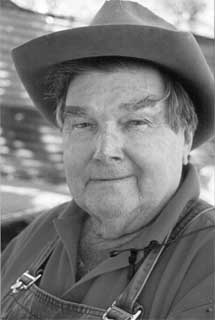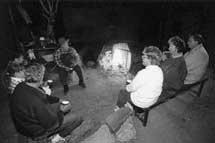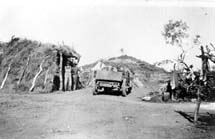Col Bremner
The man from the Dot Mine talks about
the good old days and the good new days
I first came in to Tennant Creek in the mid fifties. I had stockman
out at Dalmore Downs on the Tablelands and I come in here to pick up
a truck from Kittle Brothers, nice little truck. That's the first I
ever seen of Tennant Creek.
Back in those days that was before the water was there. And well it
was just another bush town you know, and I'd seen that many bush towns
much like it, it was no different than a lot of the towns I'd seen throughout
Queensland.
It was around 1956 and mostly everything was galvanised iron, the buildings
and the houses. And you still see a few of them around town now, the
old original houses that I'm talking about. The Goldfields Hotel was
there and so was the Tennant Creek Hotel, actually it was the Tennant
Creek Hotel I went in to. What I remember quite vividly about it when
I went into the bathroom, there was this big notice there you couldn't
help see it - Please turn off the tap when you've finished as water
is precious. Because water had to be carted into town in those days.
At the time I didn't realise they were carting water here, I just come
into town and most of the country towns I'd been into in Queensland,
if they weren't built on a water course or a big water hole they was
artesian. So I'd never been into a dry town before, this was the first
one.
So I took the truck back to Dalmore Downs and then, while I was still
head stockman there, I was sent down to Queensland to find a mob of
lost cattle. And me and two Aboriginals spent about fourteen months
down there waiting for the drought to break so the cattle could be moved
on the stock route. The stock routes were closed and they had to wait
until they opened up again and rain so they could move. Once we'd got
rid of the cattle that we'd located and mustered up I came back to Dalmore
to take up my duties again as head stockman.
But I didn't stay too long, I went back to Queensland again and started
horse breaking and a bit of prospecting around the Anakie district.
I got a message from a fella I met while I was on Dalmore. He'd purchased
Dunmarra Station and he wanted me to go up there and manage it for him.
He also wanted me to bring my plant of horses up, I had 36 horses. So
me and two dogs left central Queensland and headed for Dunmarra.
It took me three months to get them up there. I stayed with him for
maybe about six months I suppose and I got word that my father had died.
I went back to bury me father and met my wife and married her. I brought
her back and we stayed with Dick Scobie at Hidden Valley until after
the baby was born and then we went into Daly Waters and my wife took
over running the Post Office and I was contract mustering with my horses
around there then. We used to take the cattle up to Larrimah and truck
them from Larrimah up to Darwin by rail.
After my third child was born, I'd sold my horses by this time and I
got a job with the PMG as a linesman and the Post Office of Daly Waters
was sold to the Police as a Police Station Post Office.
They had a house for me in Tennant Creek so we came down to Tennant
Creek - but I couldn't live on the wages down here with three kids.
In those days linesman's wages was one of the lowest in the country.
It was the pay that made my mind up - I bought home $91 for a fortnight.
Well this was in the early 1960's and it still wasn't a lot of money
in those days! I said to the wife, "I'm not selling me labour for
this price".
So I went out to Peko and they put me on immediately as they knew me
from when I used to do work for them with the PMG. They wanted a linesman
to work on their telephone and power lines.
I spent eighteen years with Peko. I left there when the price of gold
rose in the eighties and took up leases around here and started prospecting.
The Dot Mine lease I took up because of the waterhole that's here. I
used to bring the alluvial dirt in from the Mascot and we washed it
here and treated it.
That went on for about ten years on and off. I left here and went to
other places but come back again for my leases here and we'd find another
patch and think we were going to get rich again and put it through and
get a few ounces of it but then it would cut out again.
This went on and off for about ten years. The wife and I took our grandkids
from Adelaide across to Tasmania when the pilot strike was on in about
1989 or 90. When I saw what they were doing in tourism down there with
the old convict days I reckoned well I've got the same thing here with
this old mine that was put in here - a part of history.
I started doing tours here in 1990. I started off doing day tours and
I had certain times that people had to be here, but of course they'd
be wandering in like Brown's cows. You'd be up on the hill there doing
a tour and no sooner finish and someone else would drive in and you'd
walk up there again.
I nearly died doing that, walking up and down that hill all the time.
So then I decided it'd just have to be particular times that I'd open
up. It still doesn't work, they still come in at different times!
But I'd always had a bit of an idea that there was a market here for
tours of a night-time. I had to plan out how I was going to work it.
I couldn't see people being able to find their way out here of a night.
So I had a talk to Mike Baker who was running Ten Ant tours and he agreed
to cart the people out here and we'd divide whatever we collected, half
for him and half for me.
The night tours took off like a house on fire and in those days I never
charged for children. But we put a price on children of a night because
I could visualise in the night-time here, while we're talking, there'd
be kids running mad around the place and ending up falling in the waterhole
or somewhere else. But anyway, people were coming out here as families,
it was somewhere to bring their children at night. And the children
were one of the best audiences you'd ever seen; they were just sitting
down spellbound with the atmosphere of a campfire and stories around
it of a night-time.
This went on for quite a while so I cut out the day tour and started
just doing the night tours. I used to light the mine with a 240 volt
generator but someone stole my generator.
I was going to stop doing the tours because I wasn't really making any
money when I first started off. But I thought I'd buy a battery and
take it home and charge it up and then light up the mine with 12 volts.
I've been doing the tours for over ten years.
So have you always had prospecting in your blood?
Ah yes, I used to prospect through Queensland as a teenager. The first
shaft I helped sink, we were going underneath basalt to an old deep
lead where the colours are gold. That was the first shaft I worked on
around 1954.
Do you reckon that with the way mining companies work nowadays that
there's still room for the small time prospector?
There is, but you see the small fella has to find gold on the surface.
When I say on the surface, even tracing it even if it's underground
you've got to get your lead on the surface to follow it up to find it
and there's not much of that left anymore.
There'll always be fellas chasing it because nobody gets all the gold,
there's always some there. It doesn't matter how well the field has
been worked, someone will always find a little bit.
Maybe not a fortune but if you keep looking. It never did worry me much
whether I was finding payable gold or not. Of course every man wants
to find payable gold but I just wanted to find the gold.
It was just the challenge, it was a challenge because it does the opposite
to what you think it's going to do. You're dealing with where nature
put it but then suddenly where it normally is, it's just not there.
I found one piece of gold after this last wet and I can't imagine how
it got there. But there it was sitting right on top of a bit of flat
rock. Now how it got there I've got no idea; it wasn't washed there
by water because water never goes where it was.
I'd been over that place time and time and time again. I knew the flat
rock, I'd seen it all the time and yet this piece of gold was just sitting
on top of it. It was right there but it's not there now I tell ya!
Other times I've worked a whole area with detectors, gone over it and
over it, and the one day I found a nugget just sitting on the surface
a day after the wet. Yet I'd gone over all that area thoroughly with
a detector and never got nothing!
What about the history of the Dot Mine?
The fella who worked here put the horse before the cart as the saying
goes. He was developing the mine and he hadn't found the gold, he'd
only found traces of gold. He followed a lead in and he found a small
ore body that Jeff and Len Kittle took down to the Afghans Battery and
got crushed. They say it went five weights to the ton and he got about
sixty ounces out of it so he would have put through about 240 ton out
of it to get that.
It certainly didn't pay by any means, he would have lost money out of
it by the time he paid the Kittles and paid the Afghan and the time
he actually spent on everything, it would have cost him money.
But he believed that he hadn't reached the main ore body and so he started
to put a second adit in and he was going to go in underneath where he
found another lead going out. He was going to make this big enough so
he could put a rail down and a trolley on rails.
The war stopped him, but the war done him a good turn because I'm pretty
sure it was only just a dream he was living. He bought an old stamp
battery and put it over here.
They've got that in front of the Tourist Association building - that
five stamp came from here. It never worked, but he unloaded it there
and he had this hole he dug here and apparently he was going to pump
the water in the wet season and crush his ore.
He built all around up here with the dirt and rocks he took out of there,
he built a wall around here to hold his tailings. We made it better
than it was and we used the same thing. I kept the water in there by
carting it out from Tennant Creek. But of course back in his days there
wasn't enough water, there was no water in Tennant Creek, so he couldn't
get it from there.
What sort of people worked the old mines?
I had a woman one night here and her father owned the Black Cat and
she was asking me about it. I had a map of all the mines and I gave
her a copy.
That's on the eastern field. What they used to do with that hole, Caroline
mine is the same and Wilowra. The gold was found on the surface and
when they find the lead they dig down and find out how far down it goes.
The actual ore body itself is what they found on the surface and as
they went down they found they were in gold all the way, payable gold.
They go down and bottom it and so they've got a shaft down there to
the bottom.
Then they'll go away from where they reckon they are close enough from
where they can work it and they put a second shaft down. They drive
from that shaft at the bottom to this one.
They link the two up and they start blowing their dirt from the bottom
of this first shaft they dug, they set their chargers at the bottom
of it and they blow the bottom and keep blowing it so it drops down
as it's being blown.
They take it to this other one and it's wound up and that's how they
get it out. It had me beat when I first seen them, how the hell did
they get it out, it's too wide! And straight down! The North Star was
like that too, the gold was found on the surface.
These days of course they can open cut but this was all done by hand.
If you have a look around enough you'll find the shaft where they went
down and where they went in.
There were two tracks, there's one that goes to the Telegraph Station,
that was for their water and the other one comes to Tennant Creek for
their supplies. All the mines went in two different directions. From
the Black Cat they'd come back to just past Mammoth tunnel and there
was a track there going to the Telegraph Station. In wet weather there
was water in small holes and creeks in there too. This is probably before
the war, a lot of them cut out when the war ended. Nothing ever carried
on afterwards, but they pretty well cut the gold out.
Did they make a living out of it those blokes?
Oh yeah, some of them got a good crushing out of it. They were only
small deposits but some of them were pretty rich. The biggest ore bodies
were along the Mt Samuel fault, which encompasses Eldorado, Nobles Nob
and White Devil and Warrego, all on the one line.
The ones they found on the hills off it, they were rich patches some
of them, very rich, but they weren't big like what we talk about now.
They weren't big enough for a company like Peko to work. They had to
be a big ore body for Peko to work. The Nob was working smaller ones,
they'd work shows and just send two men out on them and work that. But
because Peko was after copper mainly when they came here in the first
place.
At Juno they struck with gold there. That was the first good gold they
struck. Although they bought the Peko mine for gold you know. Before
they actually started work on it they put a drill hole down below the
water table, which is about six hundred foot down. That's the first
anybody knew what was down that deep, because the gold was found on
the surface and they used to just loam it. When they went down below
the water table at Peko, they struck massive copper deposits and in
the fifties copper was worth more than gold because gold was still pegged
at 15 pound an ounce. That's really when the town went ahead. The government
decided to bring water in to the town then.
Which years would you say were Tennant Creek's heyday?
The late 70's and early 80's, when you had all the big mines working
and the smelter. Warrego was that big there was two caravan parks as
well out there. Camps were full and housing areas were full. They had
the meatworks going down here and they had the smackery up the top.
That was when it was big, you could sell houses in Tennant Creek then.
You never saw a FOR SALE notice up anywhere, you didn't have to. There
was not enough office blocks, that's when they started building office
blocks. There was no office space in Tennant Creek at all.
So what are your plans now?
I'm just working up at the Battery now giving them a hand and taking
people through the underground tunnel they got up there. It's a replica
of what Peko was first like when I first went there in the early 60's.
So you got a few years left in you yet climbing up that hill?
Oh yeah, I'm only 70, I'm not old yet. Three score and ten they reckon
you live for don't they?


Yarning ’round
the fire — the tourists love it.

Otto Wohnert and friend
at The Dot mine during the 1930s.
